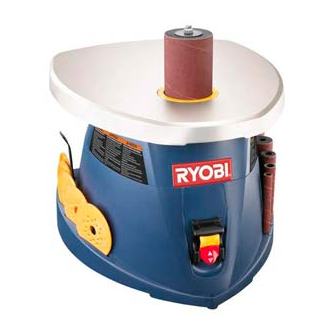
Table of Contents
Advertisement
Your new oscillating spindle sander has been engineered and manufactured to Ryobi's high standard for dependability,
ease of operation, and operator safety. Properly cared for, it will give you years of rugged, trouble-free performance.
WARNING: To reduce the risk of injury, the user must read and understand the operator's manual.
Thank you for buying a Ryobi oscillating spindle sander.
SAVE THIS MANUAL FOR FUTURE REFERENCE
OPERATOR'S MANUAL
Oscillating Spindle Sander
OSS500 - Double Insulated
Advertisement
Table of Contents

Summary of Contents for Ryobi OSS500
- Page 1 Your new oscillating spindle sander has been engineered and manufactured to Ryobi's high standard for dependability, ease of operation, and operator safety. Properly cared for, it will give you years of rugged, trouble-free performance. WARNING: To reduce the risk of injury, the user must read and understand the operator’s manual.
-
Page 2: Table Of Contents
Pay close attention to the safety rules, in- cluding Dangers, Warnings, and Cautions. If you use your sander properly and only for what it is intended, you will enjoy years of safe, reliable ser- vice. -
Page 3: Rules For Safe Operation
RULES FOR SAFE OPERATION Safe operation of this power tool requires that you read and understand this operator's manual and all labels affixed to the tool. Safety is a combination of common sense, staying alert, and knowing how your tool works. READ ALL INSTRUCTIONS ■... - Page 4 ■ REPLACEMENT PARTS. All repairs, whether elec- trical or mechanical, should be made at your nearest authorized service center. ■ WHEN SERVICING, use only identical Ryobi re- placement parts. Use of any other parts may create a hazard or cause product damage.
-
Page 5: Double Insulation
RULES FOR SAFE OPERATION The purpose of safety symbols is to attract your attention to possible dangers. The safety symbols, and the explanations with them, deserve your careful attention and understanding. The safety warnings do not by themselves eliminate any danger. The instructions or warnings they give are not substitutes for proper accident prevention measures. -
Page 6: Specifications
■ Remove the packing materials from around the tool. ■ Lift the tool carefully from the box and place it on a level work surface. NOTE: The sander is heavy. Ask for assistance if necessary. ■ Do not discard the packing material until you have carefully inspected the tool, identified all loose parts, and satisfactorily operated the tool. -
Page 7: Features
A standard 2-1/4 in. (57.2 mm) dust exhaust port is provided to help keep dust to a minimum. It is located under the table top on the back of the sander. The end of a standard shop vacuum hose fits tightly inside the dust exhaust port. -
Page 8: Features
TABLE TOP EXTRA SANDING SLEEVE/WASHER STORAGE AREA WRENCH STORAGE AREA THROAT PLATE STORAGE AREA EXTRA SANDING SLEEVE/WASHER STORAGE AREA SANDING SLEEVE/ RUBBER SPINDLE STORAGE AREA WARNING: Do not attempt to modify this tool or create accessories not recommended for use with this tool. Any such alteration or modification is misuse and could result in a hazardous condition leading to possible serious personal injury. -
Page 9: Adjustments
Finally, use finer grit for finishing the surface. Always continue sanding with each grit until the surface is uniform. NOTE: Do not use the sander without a sanding sleeve. Doing so will damage the rubber spindle. Select and install the desired sanding sleeve for your particular application. -
Page 10: Installing Sanding Sleeves
REMOVING SANDING SLEEVES See Figure 3. Follow these directions to remove sanding sleeves. ■ Unplug the sander. WARNING: Failure to unplug the tool could result in accidental starting causing serious injury. ■ Grasp and hold the sanding sleeve on the spindle. -
Page 11: Adjustments
SLEEVES See Figure 5. Follow these directions to install 1/2 inch (12.7 mm) sanding sleeves. ■ Unplug the sander. WARNING: Failure to unplug the tool could result in accidental starting causing serious injury. ■ Place the lower spindle washer over the spindle, fin side down. -
Page 12: Operation
■ Place the sander on a sturdy work surface, e.g., work stand, workbench, counter top. ■ Mark the holes in the sander base with a pencil. ■ Remove the sander from the work surface. ■ Drill three holes through the work surface. -
Page 13: Operating The Sander
■ Feed the workpiece gradually against the sanding sleeve from right to left. WARNING: Do not let the workpiece contact the sanding sleeve before you turn on the sander and allow it to develop full speed. WARNING: When you feed the workpiece from right to left, the rotation of the sanding sleeve sands against the workpiece. -
Page 14: Maintenance
WARNING: When servicing use only identical Ryobi replacement parts. Use of any other parts may create a hazard or cause product damage. GENERAL Avoid using solvents when cleaning plastic parts. Most plastics are susceptible to damage from various types of commercial solvents and may be damaged by their use. - Page 15 NOTES...
-
Page 16: Parts, Ordering, And Service
Ryobi Authorized Service Center. Be sure to provide all pertinent facts when you call or visit. Please call 1-800-525-2579 for your nearest Ryobi Authorized Service Center. You can also check our Web site at www.ryobitools.com for a complete list of Authorized Service Centers.














Need help?
Do you have a question about the OSS500 and is the answer not in the manual?
Questions and answers